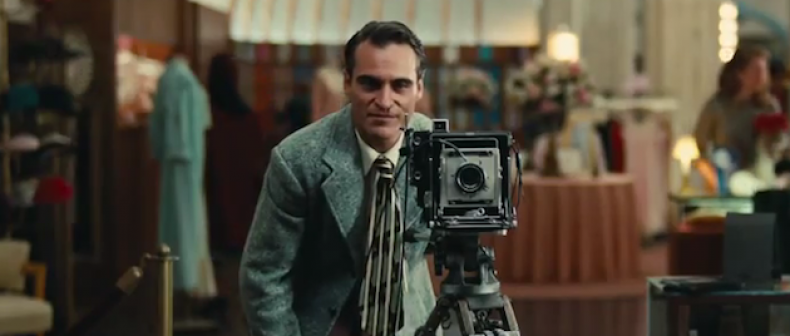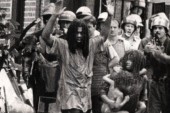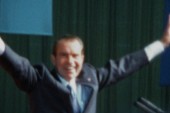
“The Master”
Paul Thomas Anderson’s spellbinding but increasingly confounding The Master begins in 1945, at the tail end of the war. After an aborted tour of duty in the South Pacific — cut short due to “kidney troubles,” or, more precisely, boozing — dissipated navy man Freddie Quell (Joaquin Phoenix) sits in a doctor’s office intently interpreting inkblots. The first image, he decides, is “a pussy — a woman’s pussy.” The following image is “a cock goin’ into a pussy.” The third is “a cock, just upside down.” With this one scene, Anderson is telling us pretty much everything we need to know about Freddie: not just that he’s horny, crude, and practically preconscious, but that he’s spectacularly undefended. Freddie is also quite clearly frustrated, psychically as well as sexually, and he spends the months following his discharge aimlessly drifting from job to job, town to town. To an extent, he’s like other veterans: unsure how to return to civilian life. But Freddie’s estrangement goes deeper. It’s not just civilian life that stymies him, it’s the whole new world of middle-class prosperity.
Anderson conveys Freddie’s lurching non-progress with travelling shots that double back on themselves. During Freddie’s brief stint as a department store photographer, Anderson pans from Freddie and his camera to his stuffed-shirt businessman subject; then, when Freddie starts a pointless brawl with said subject, Anderson reverses direction, following Freddie as he gets booted from the store. Then comes Freddie’s stint on a farm, which begins with a downward diagonal pan as he tends a row of cabbages, and ends in an upward diagonal pan as he gets chased across the field by a bunch of migrant workers. (He accidentally poisoned one of them with his favourite alcoholic additive: paint-thinner.) Finally, we reverse direction yet again as Freddie drunkenly stumbles across a party on a large yacht — one about to set sail from the Golden Gate Bridge to New York via the Panama Canal — and steals aboard. Here, Freddie’s flailing ceases, at least for a time.
Discovered passed-out below deck, Freddie is brought before the master of the vessel, the grandly magnanimous Lancaster Dodd (Philip Seymour Hoffman). Sitting alone at his typewriter, his noble, weary head illuminated by a single desk lamp, Dodd welcomes the young man and introduces himself. “I am a writer, a doctor, a nuclear physicist, and a theoretical philosopher,” he says. “But above all, I am a man, just like you.” With that cleared up, Dodd goes on to explain that Freddie has boarded a floating classroom dedicated to a new belief system called “The Cause” — later described as Dodd’s “gift to homo sapiens” — and he invites Freddie to take part. Immediately, both men are aware they’ve found something in the other: Dodd an unusually misshapen piece of clay he can mould, and Freddie a father figure, someone who might lead him out of himself. At Dodd’s request, Freddie brews up another batch of semi-toxic hooch so they can toast their momentous meeting.
Dodd is, as everybody knows by now, a thinly disguised version of L. Ron Hubbard, the founder of Scientology. But the movie isn’t the damning exposé of Scientology many were hoping for. While Anderson keeps us aware of the numerous bizarro aspects of The Cause (past lives, alien races, “processing,” “time-hole work,” etc.), he doesn’t view Dodd as a charlatan exactly. Unlike the preacher Eli in There Will Be Blood, Dodd believes his own bunk (or seems to anyway), and if Anderson doesn’t respect the belief, he respects the urge to believe. The few times we hear open skepticism of The Cause, the naysayers are depicted the way Dodd might see them: puny, ineffective, smug. They may be right to doubt Dodd, Anderson seems to be saying, but they’re wrong to settle for mundane non-belief.
To Anderson, Dodd and Freddie are essentially heroic in their yearning for transcendence, and he sees something noble, even beautiful, in their attempts to find it in one another. Indeed, the highlight of the film is a lengthy scene shot in extreme close-up in which Dodd subjects Freddie to the ritual of “processing,” a sort of encounter-therapy technique meant to break down one’s ego. Though initially resistant to the hugely intimate nature of Dodd’s questions, Freddie pushes through, slapping himself for every lie or half-truth until he’s fully, fearlessly exposed. We may question Dodd’s techniques, but there’s no question they’ve enabled Freddie to achieve some degree of transcendence here. (Phoenix’s raw, open-wound performance is, in moments like this, transcendent in its own right.) And while the emphasis is on Freddie’s breakthrough, it’s a breakthrough for Dodd as well — if his techniques can redeem this irredeemable man, there can be no doubt of their validity.
I hate to say this, but the movie peaks there, about halfway through. Or, if not there, shortly thereafter, when Freddie and Dodd get tossed in jail for a night, leading Freddie to question Dodd’s claims for the first time. It seems to me this is where Anderson should’ve broadened his canvas, not to deemphasize the two men, but to place them in sharper relief. Instead, the handful of supporting characters — including Amy Adams as Dodd’s wife, Jesse Plemons and Ambyr Childers as his adult children, and Laura Dern as an early acolyte — remain firmly in the background, and Anderson retreats into repetition and willful oddity. Over and over, Freddie reverts to his dissolute ways — usually by getting into brawls with Dodd’s detractors — then Dodd tries to return him to the path via nutty spiritual exercises. At the same time, Anderson attempts to create the illusion of thematic momentum with artfully cryptic bits: Freddie randomly being felt up by Dodd’s daughter; a party scene where all the women suddenly appear naked; a character singing Frank Loesser’s “On a Slow Boat to China.”
Increasingly in his career, Anderson seems to be settling for these sorts of elusive surface details rather than doing the work of illuminating his characters’ interior states. (Not coincidentally, he’s also increasingly drawn to hardheaded, non-reflective characters.) Nevertheless, The Master is, to my mind, an improvement on There Will Be Blood (which also devolved into crypto-kookiness) in that the two leads, as static and impenetrable as they prove to be in the end, at least yearn and ache and roil. Daniel Day-Lewis’s Plainview was so consumed by selfishness and drive that he was a non-person, with no depths to be plumbed. To the extent that the character was meant to embody soulless capitalist striving, the conception had a formal integrity, but it had nowhere to go and left no one to engage with. The Master is a more unresolved, and thus more sophisticated, look at mastering oneself and others, at the need of humankind to lead or be led.
Incidentally, it probably shouldn’t come as a surprise that Anderson treats Dodd and his wacky religion with a degree of respect. A belief in art — which Anderson so passionately possesses — is, after all, a sort of religion in itself, a search for meaning and significance. And Anderson shares with Dodd (and with Kubrick and Malick) the flaw that afflicts so many smart, high-minded types: the tendency to forget that transcendence means getting beyond oneself. At his worst, as in the last hour or so of The Master, Anderson is no different from Dodd in that he aims only to bewilder and dazzle us. In these moments, Anderson himself becomes our object of contemplation and worship. There’s nothing to wonder except: what’s going on in his head? But at his best, as in the processing scene, Anderson goes beyond inscrutable auteurism by sending us up and out of ourselves.
____
Scott MacDonald writes about cinema for Toronto Standard. You can follow him on Twitter at @scottpmac. He just started tweeting, so be gentle with him.
For more, follow us on Twitter @TorontoStandard and subscribe to our newsletter.














